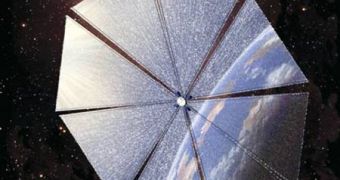Shortly after the beginning of manned spaceflights, some engineers considered the possibility of navigating through space propelled solely by the power of solar winds, in very much the same way a ship does so on Earth, using its sails to capture the wind. The first actual tests of such a system date back to the early 2000’s, but attempts since then have largely failed, mostly due to delivery system malfunction. A Japanese one was successfully launched in 2004, but accurate control was not demonstrated. Now, a US company plans to try that again, this time keeping previous lessons in mind.
California-based Planetary Society was among the first to attempt to fly a solar sail-driven spacecraft, with its Cosmos-1 craft, launched in 2005. A problem with its Russian rocket, however, caused the mission to fail. When NASA launched its first prototype, named NanoSail-D, it failed because the experimental SpaceX-constructed Falcon 1 rocket did not reach its destination. “In Cosmos-1 we had a more conventional spacecraft, but the technology has moved ahead now. You can actually get a higher performance sail with a lower mass spacecraft,” says Planetary Society executive director Louis Friedman, quoted by Space.
At this point, it may be that the NanoSail-D is the best option for basing future designs of solar sails, experts with the company believe. And given the fact that NASA still has back-up hardware of the design in storage, Planetary Society is seriously considering investigating this possibility. The Space agency announced before launching its prototype that the craft had solar wind pressure sensors, as well as the ability to record variations in the Earth's atmospheric drag. Still, it lacked any means of control. Conversely, Cosmos-1 had no such sensors, but featured a radio system, an imaging system and a micro-accelerometer that enabled some control over the spacecraft.
The California-based company is seriously considering drawing a “mean” between the two designs, and producing a spacecraft that would feature the best of both worlds. Because science has come a long way since the early attempts, it may be that the new design will be a lot cheaper than the original, a $4 million price tag on Cosmos-1. “If we can reduce it by half, we'd be pretty happy,” says Friedman. In addition to the savings, a smaller size would also allow for solar sails to be deployed from Russian Soyuz missiles, from European Ariane V, or from private American ones, such as the new generation of Falcons.

 14 DAY TRIAL //
14 DAY TRIAL //